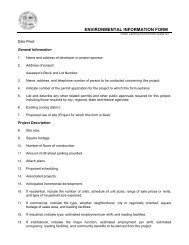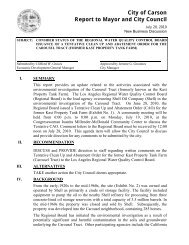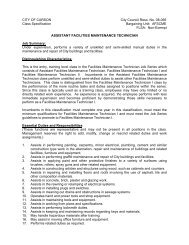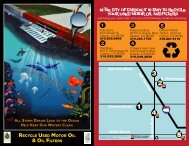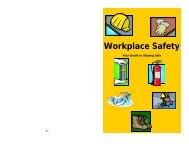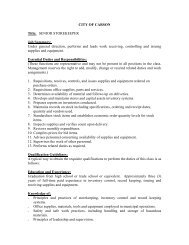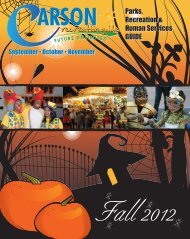aa Safety brochure
aa Safety brochure
aa Safety brochure
Create successful ePaper yourself
Turn your PDF publications into a flip-book with our unique Google optimized e-Paper software.
Test Your Accident<br />
Prevention Knowledge<br />
T F 1. On-the-job accidents take five lives each day.<br />
T F 2. Accidents are usually just a case of being in the<br />
wrong place at the wrong time.<br />
T F 3. <strong>Safety</strong> rules don’t apply to everyone, especially<br />
those who have done a job many times.<br />
SAFETY<br />
STARTS WITH YOU!<br />
T F 4. You’re more likely to have an accident if you’re<br />
tired.<br />
T F 5. Typical workplace hazards include unguarded<br />
machines and improper lifting.<br />
T F 6. The government does not require safety<br />
training<br />
T F 7. Personal protective equipment is used only to<br />
prevent chemical exposure.<br />
T F 8. Unsafe acts only endanger the employee acting<br />
unsafely.<br />
T F 9. Off-the-job alcohol or drug use doesn’t affect<br />
on-the-job safety.<br />
T F 10. Using common sense is one of the best ways<br />
to prevent accidents.<br />
Answers: 1. F. Workplace accidents kill 1 people each day. 2. F. Every<br />
accident has a cause. 3. F—you always need to follow safety rules; skipping<br />
them is asking for an accident. 4.T. 5.T. 6. F. OSHA has many<br />
safety rules that require training on topics such as hazard communication<br />
and personal protective equipment. 7. F—PPE can also protect against falling<br />
objects, heat, etc. 8. F—Other workers nearby may also be endangered.<br />
9. F—Working under the influence, or when hung over, can reduce<br />
physical and mental abilities. 10. T.<br />
16
ACCIDENTS?<br />
Do you think accidents just “happen” to people—maybe<br />
just a case of bad luck? <strong>Safety</strong> experts don’t think so.<br />
They say every accident has a cause.<br />
This booklet will help you understand what causes<br />
accidents and how you can prevent them and the injuries<br />
they result in.<br />
YOU HAVE THE POWER!<br />
Accidents don’t happen by mistake—you have the power to<br />
prevent them! Know the hazards you face and take steps<br />
to keep your workplace safe.<br />
∗ Think about what could go wrong before starting<br />
a job and take precautions<br />
∗ Use what you learn in safety training on the job<br />
∗ Put your emotions aside at work<br />
∗ Use common sense full-time<br />
∗ Follow safety rules and procedures<br />
17 American workers lose their lives on<br />
the job every day due to accidents. In addition,<br />
each year:<br />
∗ Wear the PPE that’s required<br />
∗ Encourage safe behaviors<br />
∗ More than 3.6 million disabling injuries occur<br />
at work<br />
∗ Work-related injuries and deaths cost about<br />
$121 billion—this includes lost wages and<br />
productivity, health care costs, etc.<br />
7/01 Edition © 1998—All rights reserved. #200-197<br />
Business & Legal Reports Inc., Old Saybrook, CT 06475 www.blr.com<br />
2<br />
Treat safety as one of your most important<br />
responsibilities. It is!<br />
15
RATE YOUR<br />
SAFETY SENSE<br />
How would you prevent an accident in these situations?<br />
1. You see a large puddle of water in a poorly lit<br />
area on the stockroom floor. Do you:<br />
(a) clean up the spill immediately<br />
(b) make a mental note to clean up the spill later<br />
2. You see a new employee who runs down<br />
aisles, around corners, etc. Do you:<br />
(a) explain to the employee that rules against running are<br />
designed to prevent slips, trips and falls<br />
(b) ignore the employee because you’re not his boss<br />
3. You see a machine with no guard over its<br />
moving parts. Do you:<br />
a) immediately report the missing guard and make sure<br />
no one uses the machine until one is in place<br />
(b) try to finish the job you’re working on without the<br />
guard, since you’re almost done<br />
Your safety sense should tell you the answer is<br />
always “A.” Simple acts can prevent big accidents!<br />
Exercise<br />
What other safety situations come up in your work<br />
areas? Discuss what the safe choice is in each<br />
case.<br />
14<br />
SAFETY<br />
TAKES TEAMWORK<br />
Everyone has a responsibility to prevent accidents:<br />
Federal and state OSHA establish<br />
minimum safety standards<br />
Your employer provides equipment,<br />
training, and procedures.<br />
You have the biggest job to prevent accidents. You have<br />
to:<br />
∗ Know your safety hazards<br />
∗ Always think before acting<br />
∗ Follow safety rules and procedures<br />
∗ Understand the risk of hazard<br />
exposure<br />
∗ Pay attention during safety training<br />
∗ Wear the personal protective equipment that’s<br />
required<br />
∗ Live a healthy lifestyle<br />
∗ Encourage safe behaviors<br />
in others<br />
3
WHERE ARE THE HAZARDS?<br />
You take risks every time you ignore a safety warning or<br />
forget a precaution. Some hazards are bigger than others—but<br />
all could result in unwanted consequences.<br />
Accident<br />
Flying metal<br />
fragments permanently<br />
damaged a<br />
machinist’s eye.<br />
An employee’s hand<br />
was badly<br />
crushed while<br />
trying to unjam<br />
a machine part.<br />
Prevention<br />
Wear the proper<br />
PPE for every job.<br />
Use lockout/<br />
tagout every time<br />
you maintain or<br />
repair<br />
machinery<br />
ENCOURAGE<br />
SAFE BEHAVIOR<br />
You are part of a safety team. But<br />
everyone on the team is only as safe<br />
as its least safe member. Here’s what<br />
you can do to help:<br />
∗ Compliment others when you<br />
see safe behavior on or off<br />
the job<br />
∗ Don’t tolerate horseplay, failure to wear PPE, or<br />
ignoring safety rules<br />
∗ Speak up when you see unsafe conditions or acts<br />
∗ Volunteer to help in training or be a part of your<br />
safety committee<br />
Several employees<br />
were hospitalized for<br />
breathing<br />
problems after a<br />
toxic gas release.<br />
Read container<br />
labels and MSDS<br />
to avoid chemical<br />
exposure<br />
hazards.<br />
4<br />
13
STAY FIT AND HEALTHY<br />
Taking good care of yourself can help you prevent<br />
accidents and respond quickly in an emergency.<br />
Practice<br />
good health habits:<br />
∗ Eat nutritious, balanced meals<br />
∗ Get enough sleep so your body<br />
and mind function well<br />
∗ Exercise regularly<br />
Manage stress:<br />
∗ Maintain perspective. Don’t let<br />
minor hassles become major<br />
sources of stress<br />
∗ Make time to relax your mind and<br />
body<br />
∗ Consult a doctor or counselor if you feel overwhelmed<br />
by stress<br />
USE YOUR<br />
COMMON SENSE!<br />
It’s alarming how many accidents are caused by employees<br />
who forgot or ignored simple safety precautions. Common<br />
sense is your best safety weapon!<br />
Use your head and all your senses to prevent accidents<br />
and protect yourself and your co-workers.<br />
∗ Be alert at all times to what can go wrong and<br />
how to avoid injury<br />
∗ Use your eyes, your mind, your experience, and<br />
your knowledge to identify hazards, follow safety<br />
rules, and keep your workplace safe<br />
∗ If you get a “gut feeling” that something isn’t<br />
right, it probably isn’t! Recheck your safety precautions<br />
before continuing.<br />
Beware of drugs and alcohol<br />
∗ Never work or drive under the influence<br />
of alcohol or illegal drugs—or<br />
legal drugs that can affect mental or<br />
physical reactions<br />
∗ Don’t drink to excess. It can be very dangerous<br />
to your health. And a hangover can reduce your<br />
ability to focus<br />
12<br />
5
STOP ACCIDENTS<br />
WITH A SAFE ATTITUDE<br />
UNSAFE ATTITUDES ARE…<br />
∗ Being uninformed—not participating in safety<br />
training or not paying attention to safety rules.<br />
∗ Complacency—cutting corners or not paying<br />
attention because you’ve don a job so often.<br />
∗ Carelessness—not following safety rules or<br />
rushing.<br />
∗ Being emotional—acting unsafe because of being<br />
angry or preoccupied.<br />
∗ Selfishness—forgetting that your unsafe actions<br />
can harm others.<br />
∗ Fatigue—making mental and physical mistakes<br />
because of not getting enough rest.<br />
<strong>Safety</strong> First<br />
CAUTION DANGER WARNING<br />
USE PPE FOR SAFETY<br />
OSHA rules—and common sense—often require PPE.<br />
<strong>Safety</strong> eyewear protect your eyes<br />
from flying materials, dust, fumes, or<br />
light<br />
Hard hats protect your head from blows or<br />
punctures<br />
Gloves, clothing, and footwear<br />
protect you from heat,<br />
cuts, chemicals, etc.<br />
Respirators protect against inhaling<br />
dangerous substances<br />
Ear protectors prevent hearing damage from<br />
noise<br />
When you’re assigned PPE:<br />
∗ Inspect it before each use—and don't’ use it if it’s<br />
damaged<br />
∗ Get a good fit<br />
∗ Use it to protect yourself from injury and illness<br />
∗ Follow instructions for PPE removal, storage,<br />
cleaning and disposal<br />
Most importantly—Use the equipment<br />
every time it’s required!<br />
6<br />
11
SAFETY<br />
TRAINING<br />
PROTECTS YOU<br />
A SAFE ATTITUDE MEANS YOU’RE…<br />
∗ Informed—you pay attention during safety<br />
training and ask questions about anything you<br />
don’t understand.<br />
Your employer provides training to help you stay safe on<br />
the job. Take advantage of this valuable benefit!<br />
Exercise your right to know—learn what chemical hazards<br />
you work with and how to protect yourself<br />
Use proper personal protective equipment (PPE)<br />
Always use lockout/tagout when repairing or maintaining<br />
machinery<br />
Lift safely to protect your back<br />
Be sure machine guards are used to protect employees<br />
from moving parts<br />
∗ Serious about safety—you follow safety rules<br />
and procedures at all times<br />
∗ Alert—you identify hazards and protective measures<br />
before starting a job and look for what could<br />
go wrong during a job<br />
∗ Focused—you always concentrate fully on what<br />
you’re doing<br />
∗ Team-oriented—you take responsibility for your<br />
own and others’ safety—and don’t ignore other<br />
employees’ unsafe acts<br />
∗ Fit—you get enough rest and exercise and don’t<br />
work under the influence of alcohol or drugs<br />
10<br />
7
HOW OFTEN DO<br />
YOU FOLLOW THESE<br />
COMMONSENSE RULES?<br />
Seldom . . . often . . . or all the time?<br />
Slips, trips and falls<br />
∗ Remove supplies, trash, and other materials from floors and<br />
aisles<br />
∗ Clean up or block off spills (even water).<br />
∗ Report broken flooring and torn carpet<br />
∗ Carry loads so you can see over them<br />
∗ Walk, don’t run<br />
∗ Use the railing when going up or down the stairs<br />
Tool and machinery injuries<br />
∗ Choose the right tool for the job<br />
∗ Wear eye, ear, face, and other protective equipment to prevent<br />
injury and hearing damage<br />
∗ Keep machine guards in place<br />
∗ Follow lockout/tagout procedures<br />
∗ Report and don’t use any tool that sparks, has an electric<br />
odor, smokes, or isn’t working properly<br />
Back Injuries<br />
∗ Lift only what you can handle easily<br />
∗ Get a helper, dolly, or other aid for heavy or awkward lifts<br />
∗ Squat with knees bent to pick up a load so your legs do the<br />
work. Hold loads firmly at waist level, close to the body, and<br />
8<br />
Fires<br />
∗ Check container labels and material safety data sheets<br />
(MSDSs) to learn what could burn and under what conditions<br />
∗ Use flammables and combustibles only in well-ventilated<br />
areas<br />
∗ Don’t smoke or have open flames or sparks near flammables<br />
or combustibles<br />
∗ Check electrical equipment for good cord insulation, and<br />
solid connections<br />
∗ Don’t overload electrical circuits<br />
∗ Place combustible rags in covered, airtight metal containers<br />
∗ Avoid dust and grease build-up on motors and machines<br />
Chemical spills and exposures<br />
∗ Read and follow label and MSDS instructions before<br />
starting any job with a chemical<br />
∗ Keep chemical containers closed when not in use<br />
∗ Use only labeled containers<br />
∗ Use assigned personal protective equipment and follow<br />
handling and storage instructions<br />
9



